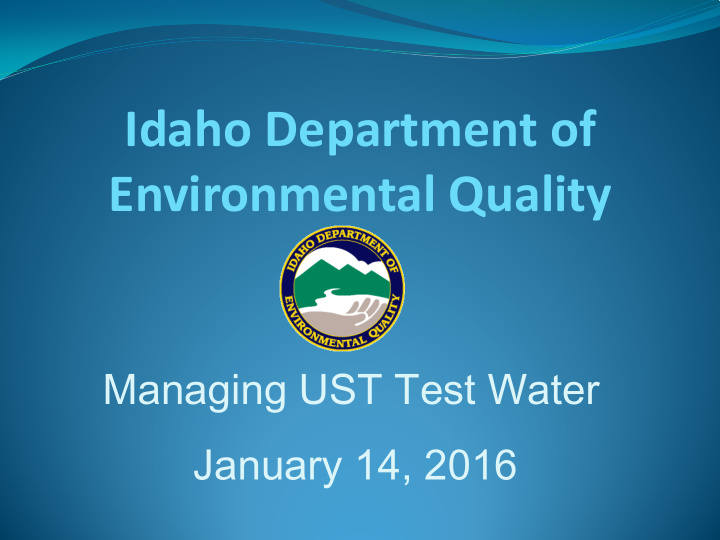



Idaho Department of Environmental Quality Managing UST Test Water January 14, 2016
What Are We Talking About? Potential hazardous waste issues related to managing hydrostatic test fluids from USTs: • Spill buckets • Tank sumps • Dispenser sumps Residues in these can cause the test fluids to be regulated as hazardous waste. 2
Testing Preparation • Inspect the spill bucket or sump. If liquid, residue, or debris is found it should be carefully removed prior to testing and properly disposed. • Clean thoroughly! • Fuel, rags, absorbents, water and other materials may need to be managed as hazardous waste 3
Test Fluid • Strongly recommend using new test fluid each time • Contaminants build up in reused test fluid • You must determine if the test fluid is a hazardous waste • If reused test fluid leaks to the environment from a sump, or is spilled, you must address the release 4
Resource Conservation and Recovery Act “RCRA” Defines and regulates Hazardous Waste “Cradle to Grave” regulation 5
Is it a Hazardous Waste? Analytical tests: • Ignitability - Flash point < 140°F ( 60°C) using Pensky-Martens or Setaflash closed cup tester (unlikely with typical test fluids) • Toxicity: Using the TCLP (Toxicity Characteristic Leaching Procedure) 6
Is it a Hazardous Waste? • Benzene is the most likely constituent to make it a hazardous waste (D018) • TCLP test – approximately $200 or more per sample for liquids • TCLP extraction on solids – an additional $175 or more per sample • Can “declare” it a hazardous waste and avoid testing 7
Is It a Hazardous Waste? YOU must figure out if it is or not. This is called a Hazardous Waste Determination. It’s required by law. 40 CFR Part 262.11 Include this step in your planning. DEQ can help if you have questions. 8
Is it a Hazardous Waste? • If testing shows it is equal to or great than 0.5 mg/L Benzene, it is a hazardous waste • Equivalent to one half of one part per million 9
How Much is Half of One Part Per Million (PPM)? Roughly: • Two drops of ink in one 55-gallon barrel • One inch in 8 miles • One second in 6 days • One minute in one year 10
While You’re Waiting for Test Results… • No mixing of test fluids from different locations prior to receiving test results • No dilution • Don’t mix potentially hazardous and non- hazardous fluids • Label containers, “Test Fluids Pending Analysis” and mark the date on them 11
If Testing Shows the Test Fluids are Non- Hazardous… • Dispose at an authorized facility. Examples: wastewater treatment plant if they’re willing to accept it, or Idaho Waste Systems for solidification and landfill disposal • May not be disposed in storm drains, surface water, or on the land 12
Hazardous Waste Transportation and Disposal • If test fluid is hazardous waste, it must be managed in accordance with all applicable requirements (see handout) • Store in closed, labeled, dated containers or tanks, comply with storage time limits • Obtain an EPA Identification Number 13
EPA ID Numbers • To obtain an EPA Identification Number, contact Rene’ Anderson at DEQ, at: (208) 373-0210 or Rene.Anderson@deq.idaho.gov 14
Hazardous Waste Labeling Requirements Containers must be labeled “Hazardous Waste” and dated. Make sure they’re closed and secure. Must be inspected at least weekly. 15
Hazardous Waste Transportation and Disposal • Uniform Hazardous Waste Manifest • Use a registered hazardous waste transporter. Prepare waste properly for shipping (packaging, labeling, marking, placarding). 16
Hazardous Waste Transportation and Disposal • Dispose at a permitted hazardous waste facility or other location authorized to accept the waste (wastewater treatment plant if they’re willing to accept it) • Comply with recordkeeping and reporting requirements including an ANNUAL REPORT to DEQ! 17
The Uniform Hazardous Waste Manifest Form that tracks the movement of hazardous waste from the point of generation to the point of ultimate disposal Doubles as the shipping document for DOT 18
Manifest Cycle 19
Who is the Generator of the Waste? • More than one person can be considered the generator of a hazardous waste • When two or more parties are cogenerators, they should mutually agree (by contract or other means) who will perform the duties of the generator on behalf of the other parties 20
Hazardous Waste UST owners/operators and UST service providers must comply with the same hazardous waste rules as other businesses Service provider can assume generator duties but it is still a shared responsibility! 21
Why Is This Important? • Liability • Responsibility Owners, operators, and service providers share the liability and responsibility. You have the duty to make sure it’s done right! It’s about protecting you. 22
DEQ Inspections DEQ may inspect your site, observe operations, review records, and possibly take samples. The purpose is to determine your compliance with the hazardous waste rules. Know where your records are! 23
Other Approaches Although the hydrostatic test is the most common, other approaches may be preferable: Vacuum methods generate no hazardous waste Install new double-walled sumps (no testing) 24
Questions? Natalie Clough Hazardous Waste Compliance Manager Department of Environmental Quality (208) 373-0506 Natalie.Clough@deq.idaho.gov Idaho Department of Environmental Quality 25
Recommend
More recommend